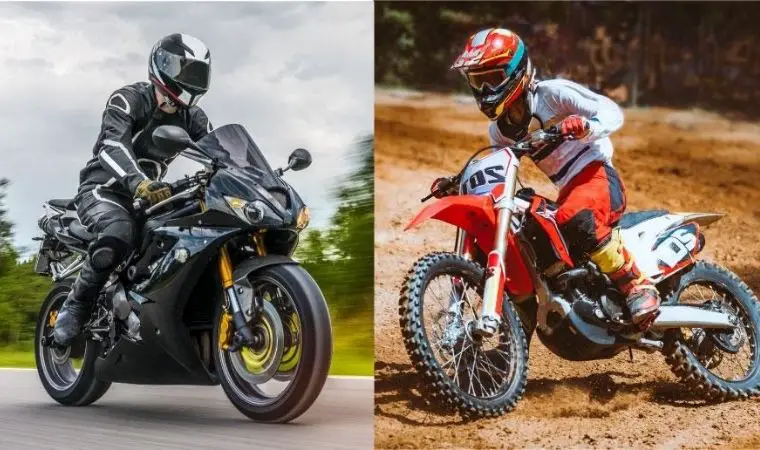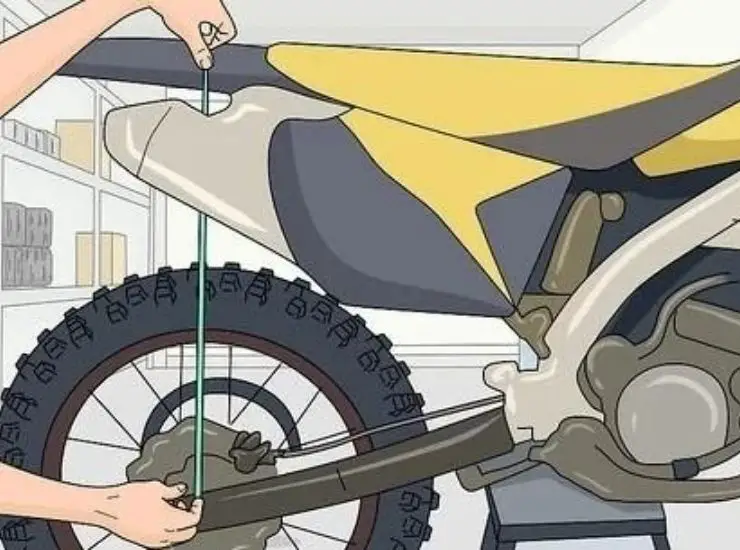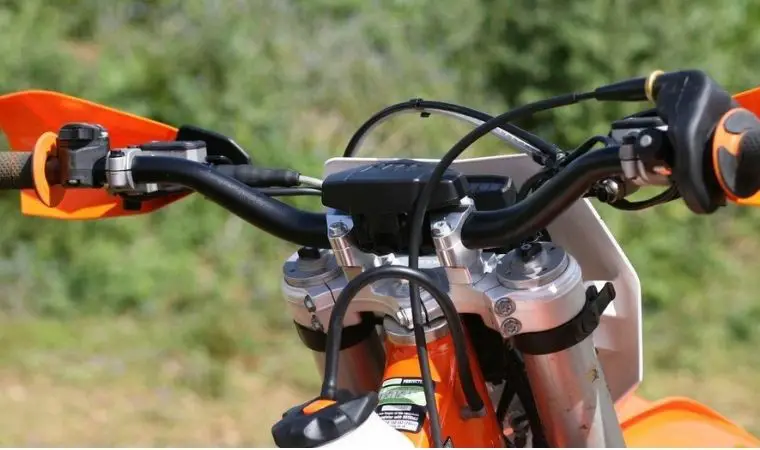Setting up a dirt bike suspension depends on some of the most critical areas: damping, preload, etc. The perfect you will play to cover those areas, the successful your bike suspension setting will be.

If you can go through the proper procedure, the bike suspension setting will not be too challenging. But remember, your bike performance will depend on how well you’re setting your bike suspension.
However, it will be an easier job if you can follow our guidelines. We have made a complete guideline where you will learn how to setup dirt bike suspension.
However, let’s see how you can set up a bike suspension.
Types of Bike Suspension Setting Areas
There are three critical types of bike suspension setting areas. And, if you can make sure a successful adjustment in those three areas, your bike performance will swiftly increase.
So, let’s know about those three key factors-
1. Sag
The most fundamental factor of bike suspension is sag. When you change the sag, it will change the height and softness of your ride. You can change the sag in terms of setting its spring preload.

A high or low speed depends on more or less the sag you adjusted.
Sag, by the way, is a significant part of controlling the movement of your body, the shoes you wear, helmet, etc. In a word, you can say that sag keeps moving while sitting on a bike. It is an amount of shock that moves under your body.
So, setting sag is too important. And make sure it is not too inflexible or too flexible. You will find your sag properly adjusted while it will be in between flexibility and inflexibility.
2. Preload
Preload controls the amount of tension on the spring. Here, more preload means a harsher ride while less preload indicates a softer ride for you.

However, it is significant to resolve the right amount of preload. The quantity of preload absorbs more energy while compressing the springs and also moving shock.
3. Damping
How fast the riding fork and shock will work, it depends on damping. To ride on a hill, shock works well when you adjust it slowly. But, in the case of rough terrain, you must set it fast.
It means, you can control the speed slow or fast through damping adjustment.

Damping works through compression and rebound. Here, compression controls the spring compression speed, and the rebound controls the expanding speed of springs.
Tools You Need
Generally, we don’t suggest any special tools for your bike suspension setting. But still, there are some necessary tools that you must need while going for setting up your suspension. Let’s see what those tools are-
How to Setup Dirt Bike Suspension
If you want to get the best result from your suspension adjusting, you have to proceed based on specific areas where to change. Users often fall into problems while they think about some specific and individual area.
Let’s not be confused anymore!
Dirt Bike Suspension Setup for Sand
When you ride your bike at a sand track, the stormy weather will not cause any severe issues. Sand usually doesn’t get stuck to the bike.
However, wet sand doesn’t bring a significant change from the regular sand setup to your bike suspension. If you are concerned about dirt bike suspension setup for sand, here is the guideline for you.

You will get the most accessible dirt bike suspension setup procedures now-
- Increase the sag speed (112-116 mm of rider sag) to a high level to enlarge stability.
- Stiffer springs will play a significant role in optimizing your bike riding experience.
- On the Xplor fork, rotate the fork adjuster caps from zero MM to 3+ MM. It will help your bike get to the track without having to jump.
- While going on the sand, make a fork pressure 5psi if you get an air-sprung fork, for example, WP’s AER fork. Now keep a few clicks on the rebound dampening to make sure the flow of returning air pressure is slow.
Dirt Bike Suspension Setup for Your Weight
Keep reading this section to learn how to adjust dirt bike suspension to your weight. Here, you need to think about sag while it is related to your weight.
It is easy to set up sag for your bike suspension. But, we recommend you get two more persons to help you.
- Use a stand to put your bike and measure the distance with the rear axle.
- Now, stand on the bike foot-pegs to get a more clear measurement.
- Bounce lightly to measure the compression distance.
- You can change the sag using a simple hammer.
- Keep the total percentage 33% (sag), and it indicates 95 to 115mm. But, we didn’t find any specific measurement.
- A complete turn can change sag 3mm.
- However, it will make your handling quicker but slower the speed if you lessen your bike sag.
Dirt Bike Suspension Setup for Woods
We found it too easy for you to set up your dirt bike suspension for woods riding. You can make a good suspension adjustment right after following a few steps.
- Slow Down the Engine
To get more power sticking on the ground, you should slow down the bike engine. It will make your ride faster. Here, you can use a heavier flywheel to slow down the engine.
And, this slow rate of your engine will prevent stalling.
- Bigger Gas Tank
Use a bigger gas tank to increase your gas preservation by 50% more. It will help you from running out your gas around 10 miles.
- Precise Suspension
You will get tired unless the spring doesn’t fit your weight. Therefore, you need to get exact springs, forks, and also the shock for your perfect bike suspension adjustment for wood.
- Spacing Gear
The most critical part will be your gear. You have to importantly make sure the size is not too high or too low.
Dirt Bike Suspension Setup for Mud
While you keep riding your bike on the muddy ground, it will surely ruin your bike age. And, the muddy water can damage the piston and rings while getting into the air filter.
Besides, the bike engine will get hotter while you keep riding on muddy terrain constantly. Also, the shock, fork, and shock linkage will smash up due to the muddiness.

But it doesn’t mean that you have to stop riding on muddy terrain. If you get four changes to your biker suspension settings, you can easily overcome the problems that happen through the muddiness.
Let’s see how-
- Choose Appropriate Tire
Choosing the right tire can make your day on mud. In this case, we prefer the Pirelli MXMS tire for your bike. But, if you have another choice, you can go ahead. Make sure the tires are perfect for running on mud.

- Loosen Your Chain
If you lose the chain, it will not stick too much mud on the bike sprocket. It will give less pressure to the tension on the sprockets.
- Proper Air Filter Positioning
Keep the air filter clean and water-free. We like you to add extra foam inside the air-box and extra oil to the filter. It will then protect your bike from sucking in water or mud.
- Use Spring Covers for Foot-Pegs
While riding on a muddy surface, it is better to keep the foot-pegs in a down position. But it is not that easy. But you can make it easy by using spring cover to your foot pegs.
Dirt Bike Suspension Setup for Tuning
To get your bike suspension in a comfortable range, you need to adjust the sag. But it requires a specific measurement. Here, you have to adjust as you need it.
However, we ask you to change three things according to the condition of your bike suspension. These are-
- Fork Oil
- Bushings
- Seals
It is our top recommendation to take help from the professionals to determine the accurate measurement. Changing these three substances will increase your bike life. And also, it will give a consistent suspension performance.
Dirt Bike Suspension Setup for Rear
- Rear Spring Preload
Here, you need to measure the rider sag first. So, to do it, put the bike on a stand and measure a straight line from the mud-guard to the axle nut.
Now, keep donning all the riding gear, including the helmet. And measure again with the same distance.
Go between 95mm and 115mm and get your possible rider sag figure.
It is now time to change the sag. And to change it, you have to loosen the lock ring. Now, adjust the spring preload ring. Next, it will result in you the following-
- Turning clockwise increases preload and vice versa.
- The more the preload, the less the sag, and vice versa.
- Each sag changes by about 3mm.
Keep repeating your process of measuring until you attain the preferred sag. But still, if you cannot achieve the exact amount, then take help from the owner’s manual, shop, friend, or the forums.
Now, you have to measure the free sag. And the measuring procedure is the same. If you get a figure less than 25mm, you need 45 mm sag to get optimal performance.
- Rear Damping
At this point, you need to make sure you have enough compression and enough rebound. And, it is because to maintain grip to avoid a bouncy ride. To do so, go through the following factors-
- Low-speed compression: Low-speed compression, you need to adjust with a nut of the reservoir when turned.
- High-speed compression: High-speed compression, you need to adjust with a separate nut.
- Rebound: Rebound is what you need to adjust at the bottom of the shock.
Dirt Bike Suspension Setup for Enduro
Here is a fundamental guide for the top enduro riders on dirt bike suspension setup-

- Make sure the bike fits your height and weight. You can change its setting even after buying according to your demand and need.
- You need to set up your bike sag before going to make your outing. But of course, considering the outing circumstance. It means whether you will make your go on muddy or sandy terrain.
- Change the shock spring into 250EXc for 69N/mm. It is a standard measurement for 75 to 85kg riders. If your weight is 97kg then the measurement should be 72N/mm.
- Also, you need to change the fork setting based on your riding type.
Read more: A Handy Guide On Dirt Bike Suspension Troubleshooting
Conclusion
Based on each area (for instance, mud, sand, wood, etc.), we tried to explain how to set up dirt bike suspension. Now, you must understand how you can do your job successfully.
But, remember that each suspension setting will bring some changes to your bike. It can have advantages or even disadvantages. But, if you consider the advantages or disadvantages, you will find them depending on your setting procedures.
Besides, these advantages and disadvantages also depend on some other categories: the terrain, tools you use, and the adjustment type.
So, be concentrated on those aspects. All the best!
